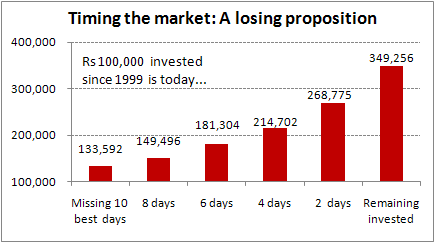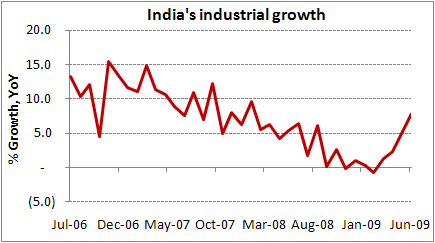A mistake that could wipe out your returns
In this issue:
» Government confident of 6% growth despite drought
» Is the US dollar at an inflection point?
» Baltic Dry Index falls 25% in nine days
» China bracing itself for a double-dip GDP growth
» ...and more!!
---------- Don't miss! Back by popular demand! -----------
Since many readers have complained that they were unable to sign up for the Equitymaster WIN A TATA NANO Offer due to the recent bank strike and RBI regulations regarding online credit card payments, we are extending the offer. But for a limited period only. (By the way, you can avoid the hassels by making a cheque payment or via netbanking). This opportunity to WIN A FREE TATA NANO is not going to honk again... so quick, click here to find out more...
--------------------------------------------------------------
| 00:00 |
Chart of the day |

|
| 00:45 |
 |
|
However, not all are convinced. Some believe that the dollar's rise just as in the month of May is a temporary phenomenon and the dollar is likely to remain under pressure till Fed raises interest rates, something that is not going to happen at least until 2011. Clearly, with the US not likely to turn into trade surplus anytime soon and with its assets not expected to generate substantial returns, interest in the US dollar is likely to be speculative at best.
| 01:29 |
 |
|
| 01:56 |
 |
|

|
How long this performance sustains is difficult to say given that erratic monsoon rains could impact demand over the next few months. This is considering that rural demand, which accounts for more than half of country's domestic consumption, is expected to be severely impacted on the back of below normal monsoon. We keep our fingers crossed!
| 02:29 |
 |
|
So, what has made the Finance Minister so sanguine despite growing worries in the agricultural belt? One is that central agencies like Food Corporation of India have buffer stocks of over 50 m tonnes of rice and wheat; two crops which have been badly hampered by lack of adequate rainfall. Also, his confidence that the government is prepared to handle a drought and that a contingency plan is also in place which would include adopting measures such as allowing import of foodgrain, continuing with the ban on exports and asking state-run agencies to buy more stocks from the open market. We certainly hope that the government's confidence is well founded. After all, India is barely limping back to some semblance of normalcy after putting the global crisis behind it. The eruption of swine flu is also casting a pall of gloom. This means that the government will have to do all in its power to make sure that these phenomena do not deal a huge blow to India's growth. A very challenging task indeed!
| 03:23 |
 |
|
| 03:49 |
 |
|
Experts are of the opinion that the enormous stimulus packages unleashed by the Chinese government have encouraged more fixed asset investment at a time when the need of the hour was perhaps to reduce capacity. Thus, as the effect of the stimulus packages wears off, the realities of excess capacities will dawn on corporates, forcing them to go slow on them and thus, leading to a slowdown in investment led GDP growth. Furthermore, the possibility of a second stimulus package by the Chinese government seems limited because the country's fiscal sustainability is less strong than it appears. A second package is only likely to make it even worse. Indeed, testing times ahead not only for China but also for the rest of the world as another of its growth engine starts to sputter.
| 04:38 |
 |
|
| 04:50 |
Today's investing mantra |
Today's Premium Edition.
Recent Articles
- All Good Things Come to an End... April 8, 2020
- Why your favourite e-letter won't reach you every week day.
- A Safe Stock to Lockdown Now April 2, 2020
- The market crashc has made strong, established brands attractive. Here's a stock to make the most of this opportunity...
- Sorry Warren Buffett, I'm Following This Man Instead of You in 2020 March 30, 2020
- This man warned of an impending market correction while everyone else was celebrating the renewed optimism in early 2020...
- China Had Its Brawn. It's Time for India's Brain March 23, 2020
- The post coronavirus economic boom won't be led by China.
Equitymaster requests your view! Post a comment on "A mistake that could wipe out your returns". Click here!
10 Responses to "A mistake that could wipe out your returns"
srinivasu chennapragada
Aug 12, 2009hi. thanks for this service.
very interesting site.
thanks
SANJAY SINGH
Aug 12, 2009Your view on timing of the market is really an eye opener and will help me to stay invested for a better return. Thanks a ton for this data.
prakash
Aug 12, 2009dear sir,
Instead of writing so much every day, kindly put your comments in a nutshell and inform the subscribers what they should do.
dont write a 5 minutes masala every day. it may be interesting to read. But what is the net effect for the investor. kindly conclude rather than elaborating.
prakash
Prasad
Aug 12, 2009The continuous updates and information you are providing about China is making this subject more and more interesting. I wonder how many more surprises like these are being held by the Dragon Nation (of course close to its chest), which will come as surprises to entire world.
Satish Tambe
Aug 12, 2009Hi,
Talking about missing best 10 days is misleading,
You never know when the best days will come,you only know it in the hindsight,
How about calculating missing the 10 worst days,
I think that can increase your returns much more,
How much returns these so called experts can give anyway
Regards,
SATISH
Kunal
Aug 12, 2009Hi,
Your 5minute wrap up is simply beautiful...one i like the most is Chart of the day and Today's investing mantra. I believe in WB's( guruji's :-) ) rules of investing and made quite a money coz of it. Keep doing the good work
Best,
Kunal
Amit Kapoor
Aug 12, 2009Hello,
Just wanted to compliment you for the graph showing "Timing the market". I think it is a powerful representation of showing the benefits of staying invested. An example is the day before election results this year. That was the one of the best days to invest, as the next day, you couldn't purchase anything. Well done.
Regards,
Amit
Akshat Kapoor
Aug 12, 2009Hi,
When you talk about missing 10 best days are you talking about the days when the market was at its peak (hence they were best in terms of redeeming the investment) OR you are talking about the days when the markets were at their lowest (and hence were best days in terms of investing in the market)?
Thanks,
Akshat


k.prabakaran
Aug 14, 2009thank you for your best services to the investor, your good guidance surely helps your clients. congrats for your services and it may leads the right direction to invest and earn once again thanking you